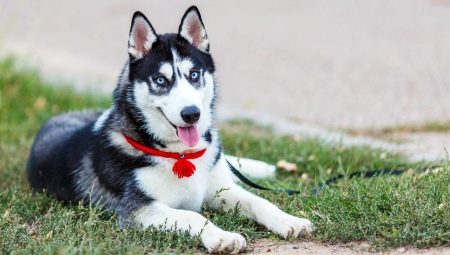Husky is a very loving, kind and sensitive breed, which, undoubtedly, will give its owner a lot of joy. But special conditions may be needed to keep a dog of this breed, and proper care is necessary to keep a dog healthy.
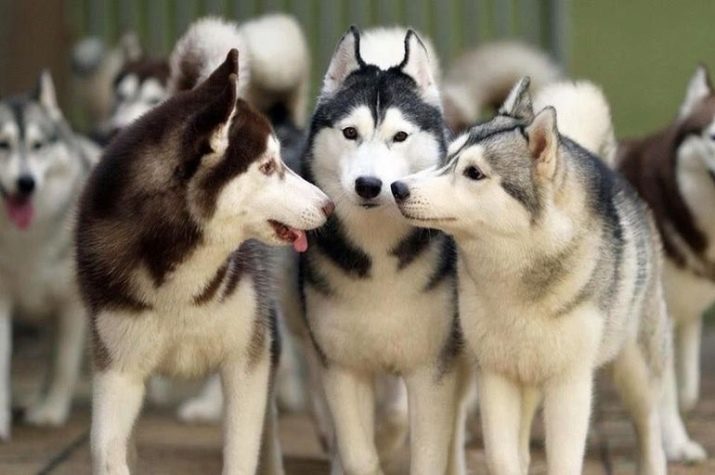
Breed description
The word "husky" goes back to the distorted name of the Eskimo people - "eski". Various northern peoples, such as the Chukchi, Kereks, the aforementioned Eskimos and other peoples living in the north of Eastern Siberia, and later various people who came to the north of North America, used dogs of this breed for transport purposes. Involuntary selection, which took place in the conditions of cold, long distances traveled, feeding (on the way) dried fish and constant loads, led to the formation of the very characteristics of a husky that make them recognizable.
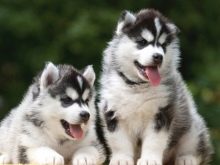
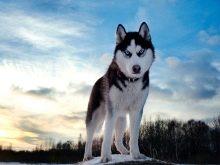

Dogs of this breed of medium height, with a dense coat, have a lean figure, some note the distant similarity of these dogs to wolves. Take a look at a more detailed description:
- the coat is long, the undercoat is very thick;
- the husky has erect ears, covered with wool from the inside;
- international standards allow up to 15 color options for dogs, but for the husky is characterized by the presence of a light muzzle and a dark periorbital region;
- the most common eye color is blue, but brown, olive and golden are also found;
- males are usually larger, their skeleton is more pronounced;
- Husky is very hardy, can tolerate long loads, moreover, females are practically inferior in terms of endurance to males;
- Husky treats all strangers very kindly, which excludes the possibility of using her as a guard dog.
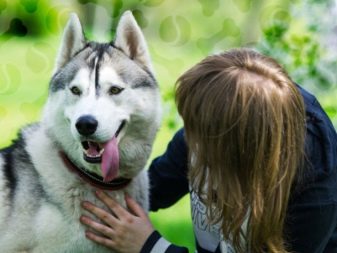
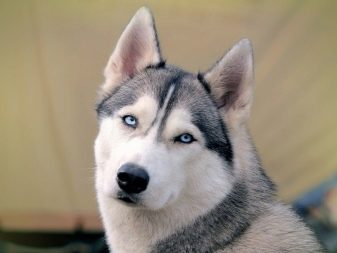
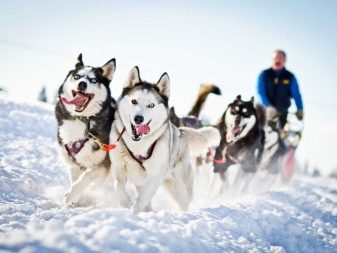
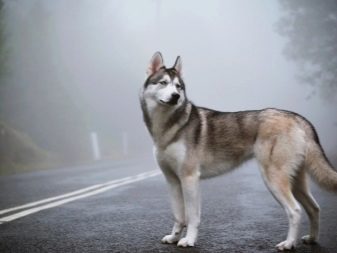
Subtleties of content
To acquire a husky, you should find a reliable breeder or nursery with a positive reputation. A puppy should be taken in the second month of life, because before that, it is very important for them to stay with their mother. When choosing a puppy, pay attention to its skeleton, it must be strong. Look at the condition of the paws, tail, bite, and oral cavity. Also, the puppy should be active, curious and relatively peaceful.
It is necessary to check with the breeder for the availability of documents for the dog, and also to check for the presence of the mark or, if any, the chip. If you are offered a dog at too low a price, be sure to watch out, as a good purebred husky cannot be cheap.
It is very important to provide the puppy with a number of accessories - a bowl for food, a bowl for water, a collar. You should also provide the puppy with a leash, underweight, muzzle. It is necessary to provide the puppy with toys that are resistant to attempts to nibble them. The dog also needs to prepare a special backpack, equipped with weighting so that the dog is not hyperactive, a cooling mat, and a furminator for grooming.
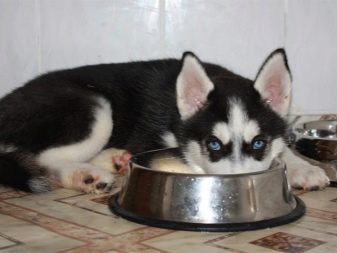
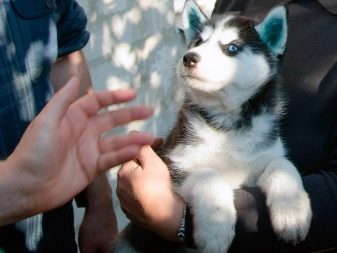
Any pile floor coverings, such as carpets and rugs, should be removed from the dog's reach — husky dogs love to tear them. Also hide clothes, shoes and valuables. It is necessary to remove glass accessories, equipment, clay pots, wires can be greased with special preparations, and it is advisable to remove various detergents away to avoid poisoning. Isolate the dog from sources of noise, sharp objects, and exposed wires.
Keep the dog in conditions regular physical activity. Each day you will have to devote up to four hours to walks, otherwise the puppy simply will not squander its strength, and one should not worry about the weather - the puppy will be comfortable under conditions from +20 to -20. The number of walks will have to be increased to three instead of the usual two for other breeds.
It is important for the puppy, in addition to just running around, to play games. In winter, a puppy from 9 months of age is arranged to ride in a sleigh and sledding, and in summer, games with balls, frisbee and similar accessories.
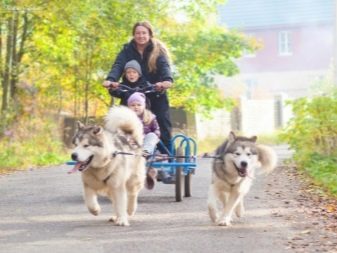

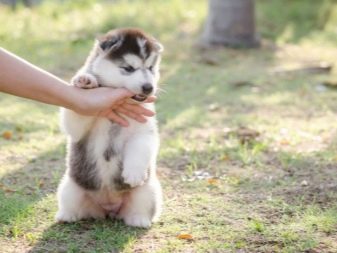
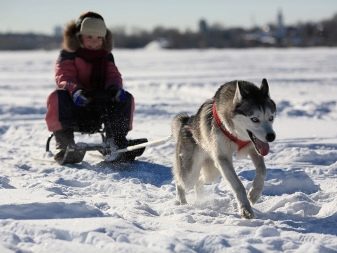
In the apartment
In the apartment interior, the husky will have nowhere to splash his energy if you do not engage in his leisure time while walking. Therefore, be mentally prepared for the fact that walls, doors and some small things can be damaged. Therefore, sometimes for a puppy it is advisable to use a spacious cage with a soft place to sleep on the floor, if the owners are forced to leave the dog unattended.
In no case should you forget to open the cage as soon as it becomes possible without too devastating consequences.
Be aware that it is not possible to demand a husky guard service in your home. As already mentioned, husky dogs are a great friend of the family and a great sled dog, but not a guard at all.
It should immediately establish prohibitions on begging, attempts to throw oneself on people, to get into the owners' bed or to climb onto any other furniture. All these nuances need to be worked out during training, which is usually started from a month and a half.
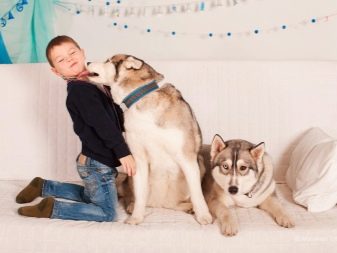



In a private house
In a private house there are more comfortable conditions for living a husky, but to organize leisure on the street you just need to open the door, you need to organize an animal full-fledged walking with games outside the yard.
In the heat, husky dogs have a very hard time, so it’s important to shelter them in the shade and provide plenty of water for drinking. It is also important for dogs to organize a spacious aviary, while not forgetting the natural ingenuity, curiosity and cunning of a husky.
Based on this, they can dig up the walls of the aviary and get out in search of adventure. To avoid such problems, you should reinforce the enclosure with a net, long steel rods, and the floor should be strengthened with something solid, so that it would not be possible to undermine.
If the husky is allowed to freely walk around the yard or outside without supervision, the dog can simply run away.
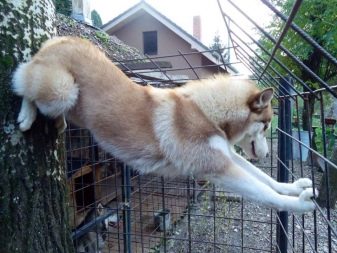
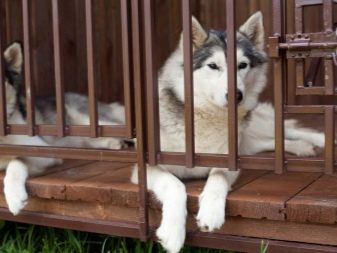
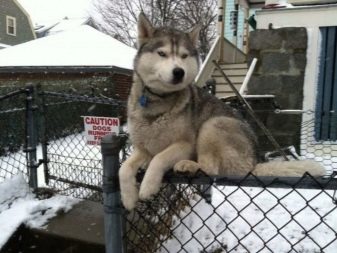
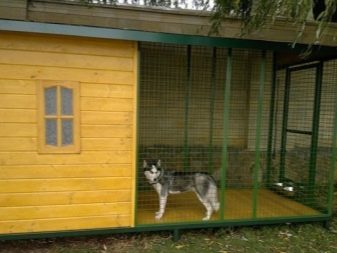
How to care?
Hygiene issues are very important in dog care. While still a puppy, a husky dog should receive hygiene procedures more often than other dogs, because he has a long coat and thick undercoat. Husky sheds twice a year, leaving a huge amount of hair behind him. If the dog lives in a comfortable climate, these periods may be less pronounced.
Up to six months, the dog is combed twice a week, after the hair coarsens to a certain extent, and then the frequency of combing can be reduced to one per week. At home, comb the dog a comb with wide teeth or a furminator. It is important to save that part of the undercoat that has not yet molted. During moulting, dogs are combed out daily, or, if the house is private, once every 3-4 days.
In addition to regular combing, the dog needs to be bathed, and those living at home - regular washing of paws.
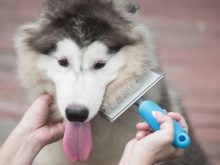
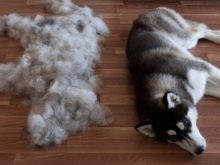
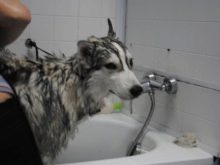
The dog should not be allowed to climb through puddles and in the mud, but if this happens, contamination can be eliminated with a wet sponge or special wipes. Once every half a month it is necessary to clean the ears and eyes of the pet with a cotton swab with a disinfectant. It is recommended to use veterinary lotions for this.
Husky should receive preventive eye drops.. In addition, specialized institutions should clean the dog’s teeth and remove stones from them. For this, veterinary clinics are ideal.
In the summer and winter, dogs need care for the pads of their paws. To do this, there are special creams, gels and even wax.
In addition, it is worth taking care of the claws of the animal. So that they do not break, thereby causing the dog discomfort, they need cut regularly to the optimum length.
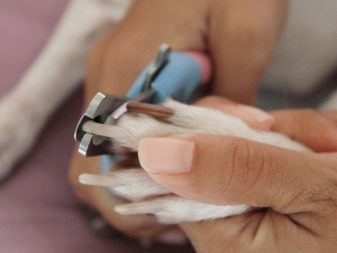
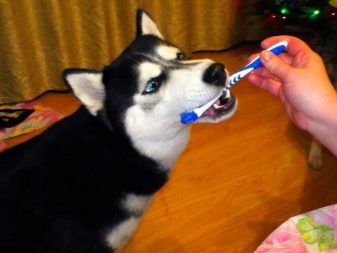
Power Features
Up to 2 months, puppies must be fed up to 6 times a day, up to 4 - 4 times a day, at 5 months, the puppy should be fed at least 4 times a day, and from six months to 10 months the puppy gets food three times every day. An adult pet should be fed up to 2 times a day.
When purchasing a puppy, some breeders recommend holding it on a rice diet for up to 7 days, subsequently connecting white poultry meat or sea fish.
At each stage, you should maintain a diet by feeding the puppy at a certain time. From 4 months, vitamins and minerals are added to the diet. Regardless of the choice of hosts between a natural product and ready-made meals, it is important for the owners to ensure the presence of immunostimulating vitamins A and C in the diet, and B vitamins for skin and muscles. Vitamin D is important for calcium metabolism, vitamin E has a positive effect on reproduction, and metal ions and non-metallic compounds form the framework of bones and tissues, and also play a role in enzymatic regulation.
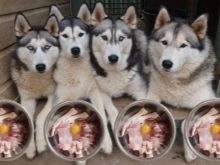
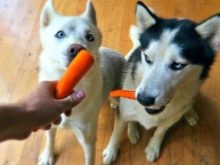

If you choose natural food, then you must follow a certain list of rules. Half of the diet should be meat (beef, turkey, rabbit) or fish. You can try offal, such as the liver, heart and other organs, which are just rich in trace elements and vitamins.
Husky is useful to feed cereals from cereals and cereals - buckwheat, rice, oatmeal. Moreover, steamed buckwheat or oatmeal can (and even preferably) be given daily. Up to two times per week can be added quail eggs. The combination of these products should not exceed 1/5 of the ration.
Even to 1/5 of the diet should be given under dairy products. On the vegetables should be given up to 1/10 of the ration, while preference is given to foods containing fiber - carrots, cabbage, apples and more.
If you decide to resort to ready-made feeds, it is important to consider the price class of the feed and how guaranteed it is to meet the needs of your dog. The choice is desirable to stop at premium or super premium price class feed. In cheap feeds, very often there are low-quality additives that have an allergenic effect, disrupt the intestinal microflora or simply give a feeling of satiety, without really saturating the dog. They contain starch, corn, and sometimes cereal supplements.
If a dry food for a puppy is taken as the basis, sometimes you can dilute it with canned food.
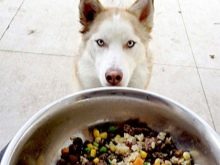
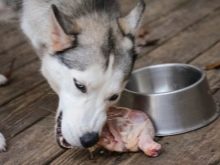
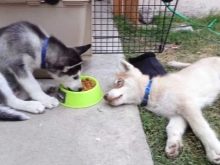
Puppies must have a ration with a high percentage of meat. Dry food can be mixed with a natural product only if it comes to the addition of fermented milk products or vegetables.
Opinions differ regarding the method of transferring to dry food. Some breeders are inclined to believe that it is possible to keep within 10 days, every 3 days reducing the share of natural food by a quarter and increasing the share of dry food by the same quarter of a serving, while others believe that this process should be stretched for 2-3 weeks. Therefore, we can conclude that the transfer to dry food should not take less than 10 days and should be a gradual process. It is also important to supply an appropriate amount of water to dry food.
Categorically it is impossible to feed huskies with sausages, sausages, flour products and minced meat. Do not feed your dog tubular bones and chicken skins. Also exclude legumes, grapes and other foods that trigger flatulence from the diet - this can cause her discomfort. Do not give dogs a raw liver, as well as river fish due to the increased risk of helminth infections, as well as the likelihood of poisoning. Potatoes and, in particular, starch contained in it can lead to metabolic disorders in the dog.
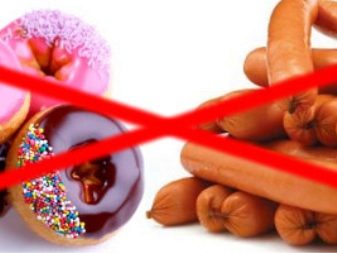

Parenting and training
Husky puppy is very active and loving, so he will gladly absorb all the attention that you give him. The first six months are critical for the formation of a “host-pet” relationship. It is important to devote all free time in this period of the life of a husky to him, playing with him, caring, walking and giving him his affection and warmth.
During walks, it is necessary to give him all his strength, forcing him to exhaust himself, so that at home he was more calm and assiduous.
Starting with the appearance of the puppy in the house, it is important to give him three main places - for sleeping, for eating and a temporary place for coping. It is also important to teach a puppy a nickname and it is absolutely necessary to wean him from the habit of playing with household things that do not belong to him.
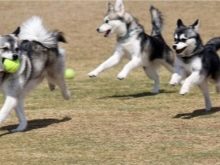
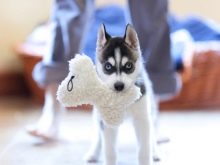

In general, when raising a husky, it is useful to introduce a number of rules.
- The role of leader should be clearly established. The leader first eats, the first gets into the house, goes at the head in any narrow aisles.
- It is not permissible to use violence against a husky. If the dog has committed misconduct - it is worthwhile to limit yourself to the command “fu”, “not”, “place” or the like, ignoring any needs of the dog until the moment when it goes back down. If the dog is persistent, it is permissible to take it by the withers and press it to the floor or the ground until the dog stops persisting and relaxes. Causing pain to the dog is strictly prohibited.
- Always give the dog a choice, reinforcing the right reward - whether it is goodies, affection, or at least approval from the owner. So you will form a positive reinforcement in the dog of the correct (from your point of view) behavior.
- Husky must have certain rules of residence, in which rooms she is allowed access, what time she eats, what time she sleeps, how she behaves during a walk, during meals, at guests, and so on.
A puppy must be given a set of minimal commands that he must know perfectly ("sit", "place", "to me", "stand" and so on).
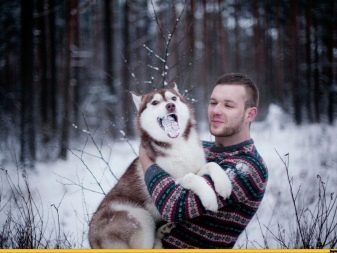
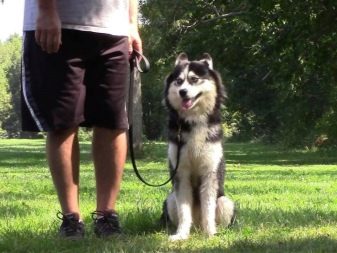

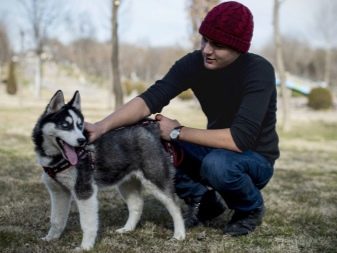
Prior to 6 months, priority should be given to forming a bond between the owner and the puppy, then you can already lean more closely on the process of education.
Punishment is acceptable only if the husky has shown aggression to the owners, to other dogs or has done something dangerous for himself.
Husky dogs love to ride children and adults on a sleigh, which can be used in the process of upbringing or as an active pastime.

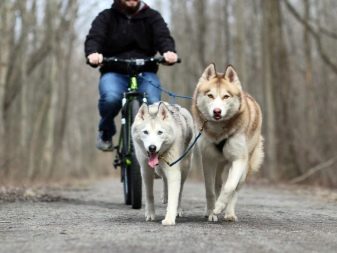
Diseases and Vaccinations
Dogs of this breed are characterized by very good health, but this does not mean that they are not susceptible to diseases, including infectious ones.
At the age of 2 months, dogs are given a combined vaccination against rabies, plague and enteritis with a second dose after a month. To prepare for vaccination as planned 10 days before it should give the puppy anthelmintic drugs. After the second vaccination, the dog is at home for two weeks, and then it can be taken outside. After a year, it will be necessary to carry out a similar revaccination.
In the warm season, it is important to protect dogs from ticks, as they are carriers of pyroplasmosis, which could potentially be fatal to the pet. To protect the dog, you can use preventive collars or pharmacological external agents, as well as drugs for internal use.
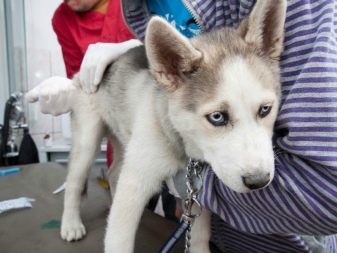
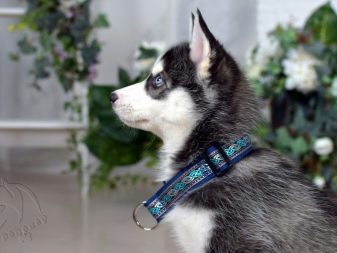
Most often, in dogs of the Husky breed, eyes, ears, musculoskeletal system and nervous system are affected, and if malnutrition occurs, internal organs, especially the digestive tract. Therefore, it is necessary to monitor the appearance, range and training, as well as the nutrition of your pet, then it will be strong and healthy.
See how to look after husky dogs in the next video.
